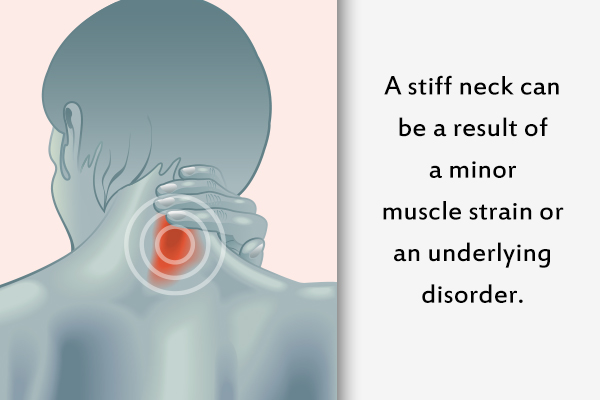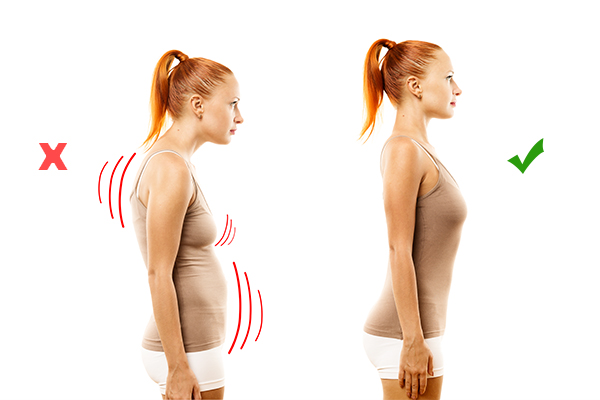In this article:
Your neck keeps your head erect throughout the day. The weight of your head falls on the neck muscles and gets distributed down the back. It is only when you lie down or rest your head on a supporting surface that your neck muscles catch a break.

The constant pressure on the neck can make it quite strained and stiff, which is one of the most common pains that afflict people across ages. It is rarely a sign of anything serious, but can be quite distressing while it lasts.
Stiffness in the neck without any additional symptoms is typically the result of strained underlying muscles. But if the stiffness is accompanied by other discomforting symptoms, it could be stemming from a more serious medical condition.
Whatever the reason may be, a stiff neck can be very uncomfortable and, in some scenarios, even quite painful. It can hinder your daily activities and make you lethargic.
Moreover, if you don’t continue overexerting your stiff neck muscles, the pain and damage will get worse and become harder to treat. So, it’s best to tend to the problem as soon as possible for a quick recovery and to avoid any undue complications.
This article discusses the various causes of a stiff neck, symptoms that may warrant quick medical intervention, and some ways in which you can manage mild cases at home.
Some Causes of a Stiff Neck

A stiff neck can be a result of minor muscle strain or an underlying disorder. Here are some of the common culprits behind this discomforting condition:
- Looking down for a long period while reading, writing, or using your phone
- Excessive or vigorous movement of the neck
- Sleeping in the wrong position, which exerts too much pressure on the neck
- Clenching the jaw
- High stress levels (1)
- Medical conditions such as osteoarthritis and spinal disorders
- Trauma to the neck or back due to injuries, a hunched posture, or picking heavy weights
- Sudden movement of the head due to whiplash, which can pull your neck muscles and also can give rise to other serious symptoms (2)
Symptoms That May Accompany a Stiff Neck
A stiff neck is typically a sense of soreness or stiffness in the neck muscles that prevents the head and neck from moving in a normal range. Sometimes, it can be mildly painful. Aside from altered range of movement and slight pain, a tension headache might also accompany a stiff neck, as well as shoulder pain that may radiate down the arm.
However, if the stiffness is accompanied by a headache and a fever, it could be a sign of meningitis. Meningitis is rare and potentially fatal infection that affects the outer cover of the brain and spinal cord. If you notice all these three symptoms together, consult a doctor immediately. (3)
Other worrying symptoms that you need to look out for are:
- Constant lethargy, fatigue, or drowsiness
- Unexplained crankiness in kids
- Vomiting
- Skin rash
- Cough and cold
- A protruding soft spot on the skull
Ways to Get Rid of a Stiff Neck
Since your neck muscles are typically very tense when a stiff neck happens, making sure to stretch and release/massage those muscles is a great way to decrease the tension and stiffness that is causing the discomfort.
You may also want to use ice or heat compress and over-the-counter pain relievers to reduce the inflammation, discomfort, and pain.
The following are some easy ways to manage your stiff neck.
1. Apply alternating cool and warm compresses

Ice typically helps to reduce inflammation and swelling, while heat does relax and loosen up tight muscles.
I would recommend using ice and heat in a rotating manner for 20 minutes at a time throughout the day, with at least 20 minutes between treatments of either option.
2. Take OTC analgesics for pain relief
Nonsteroidal anti-inflammatory drugs (NSAIDs) such as ibuprofen and naproxen are usually recommended as the first-line treatment for a sore and stiff neck. As their name suggests, these medications work by curbing inflammation in the body.
3. Massage your stiff neck with oils
Getting a massage is a way to loosen up tense or stiff muscles, although it should be done by a professional if you are in pain or experiencing discomfort that is limiting your normal movement.
The oils that may be used for pain, tension, and inflammation include: (4)
- Peppermint oil
- Rosemary oil
- Lavender oil
- Eucalyptus oil
- Chamomile oil
- Sandalwood oil
- Clove oil
4. Do neck exercises

During a stiff neck, you might want to focus on stretching and releasing the muscles. Save exercising for after the flare-up happens to prevent another episode.
The following stretches are great to target the upper and lower neck muscles on either side.
Caution: Perform each of these exercises in a slow, gradual, and gentle manner, avoiding any abrupt or forceful movements that can further injure your neck or back muscles.
a. Forward and backward bends
- Stand or sit, whichever is more comfortable for you.
- Keep your head squarely over your shoulders.
- Sink your chin toward your chest as much as you can and keep it there for 15–30 seconds.
- Gradually raise your head back up.
- Slowly lift your chin toward the ceiling as much as you can and hold it there for 10–15 seconds.
- Return to the starting position.
b. Neck stretch
- Sit with your spine erect and gaze straight ahead.
- Use your right hand to hold your left shoulder down.
- While maintaining this position, gently tilt your head to the right and stay in this position for about 5 seconds.
- Do the same stretch on the opposite side.
- Repeat 3 times on each side.
c. Side tilt
- Sit or stand, whichever is more comfortable for you.
- Slowly drop your head to the right while keeping your shoulder still. Tilt your head to the extent that your right ear touches your right shoulder, but without overstraining your neck or shoulder muscles. You can use your right hand to push down your head from the top but only to the extent that you are comfortable.
- You must feel a light stretch around the neck. Hold this position for 5–10 seconds before returning to the starting position.
- Repeat on your left side.
d. Side rotation
- Make yourself comfortable either by standing up or sitting down.
- Keep your head squarely over your shoulders.
- Slowly and gently turn your head to your right. Feel your neck and shoulder muscles stretching, and cease when you have saturated yourself. You may use your hand to increase the stretch, but do not overdo it.
- Hold the stretch for 15–30 seconds.
- Slowly bring your head back to its initial position.
- Repeat on your left side.
e. Shoulder roll

- Make yourself comfortable by either sitting or standing.
- Raise your shoulders and move them in a circular motion in a forward direction.
- Repeat the circular motion about 6 times.
- Repeat the motions but in the backward direction.
f. Rhomboid and middle trap stretch

- Interlock your fingers with your palms facing outward, and extend them forward until you feel a pull along your upper back.
- Target different parts of the back in this way by shifting your arms either downward or upward.
- Hold this position for 30 seconds.
- Relax and then repeat.
5. Consume anti-inflammatory foods
Eating a healthy and well-balanced diet is essential to keep your body at its best health, including preventing stiff/tense muscles or pain flare-ups. Focusing on overall anti-inflammatory foods can benefit your digestive system and your muscles.
Anti-inflammatory foods include:
- Fruits and vegetables – at least 1 serving of vegetables with each meal and 2 servings of fruit each day
- Healthy fats – unsaturated fats found in whole foods
- Fish – at least twice a week
- Whole grains instead of refined grains
- Limiting fatty meats and opting for lean meats such as chicken and turkey
- Avoiding processed foods and opting for more natural, whole foods, which are easier on your body and cause less inflammation
- Natural anti-inflammatory supplements and spices, including turmeric, ginger, cinnamon, cayenne, clove, and curcumin
6. Have a proper sleeping posture
Sleeping on your back is the most natural way to support your spine and its natural curves. You can also adjust your pillow thickness/height to keep your neck in its most natural position so it is not raised too high or tilting back too far.
Sleeping on your side is another way to ensure your neck is kept in a neutral position with support from a pillow and your chin facing straight. Avoid sleeping on your stomach, which puts your spine in a very unnatural position and your head to one side for hours at a time.
Preventing a Stiff Neck

Follow these simple measures to avoid injury and excessive stress to the neck muscles:
- Strengthening, stretching, and moving your neck muscles regularly can help prevent these muscles from being prone to injury, tension, or stress that causes a stiff neck. Stretching these muscles daily and performing strengthening exercises at least two times a week help prevent the onset of stiff neck pain.
- Make sure that you are sitting and standing with proper posture, not straining the neck and spine while walking, sitting at your desk, or doing other activities.
- When lifting something heavy, distribute the load equally on both your shoulders. Putting excessive load on one shoulder alone can pull your neck and back muscles.
- Stress can make your neck muscles extremely tense and stiff. So, it is important to calm your mind and body through proper stress management techniques. Exercise is the ultimate stress buster, so you must incorporate a half-hour workout into your daily routine. Don’t plunge yourself directly into any heavy lifting or strenuous exercise, which can jolt your tense neck muscles. Start with simple stretching exercises to loosen your muscles, and then gradually increase your level as your body gets used to working out. You can also try yoga, meditation, and deep breathing, which are deeply relaxing for both your physical and mental being.
- You need to get at least 7–8 hours of sound sleep every day to help your body rejuvenate itself.
- Sitting at the desk looking at your computer or documents for extended periods can put a lot of pressure on your neck and back muscles. So, take frequent breaks to move around for a bit, and use some simple exercises to flex the tense muscles now and again.
- Do not sleep on your stomach. This can put your neck under strain. You can sleep on either your side or back. It is also important to have a proper pillow and mattress that can provide proper support to your neck and back muscles while sleeping. They should neither be too firm nor too soft, as both of them can twist your neck or strain your neck muscles. What you are looking for is enough firmness to hold your head at the correct angle.
- Some people have the habit of jamming their mobile between their ear and their shoulder while taking a call. This position requires you to tilt your neck at an uncomfortable angle, which can strain or twist the underlying muscles. If you cannot hold your phone in your hands while talking, consider using earphones, but never in this position.
- Keep your laptop, book, tablet, or mobile on an elevated surface at your eye level so that you don’t have to look down to use it. You can get an adjustable laptop/reading stand for the same. When working on a desktop computer, sit on a chair with proper back support and sufficient height, and place the keyboard and monitor at a comfortable level where you don’t have to strain your neck.
- Do not ignore even mild stiffness in the neck as it can get progressively worse if not addressed properly.
Most-Asked Questions About a Stiff Neck

How long does a stiff neck typically last?
If treated correctly, the stiff neck should let up after a few days to possibly a few weeks, depending on the reason. If you simply slept wrong or you are unsure of what caused the stiff neck, you typically will not experience much pain after a few days.
Sometimes with more extreme causation such as a strain, whiplash, and spinal disorders, you might be looking at up to a few weeks or even months of recovery time, accompanied by the above-mentioned shoulder pain and headaches.
Are acupressure and acupuncture helpful when suffering from a stiff neck?
Just like with a massage, acupressure and acupuncture should be performed by a professional. They have both been found as effective ways to relieve stiff neck pain and chronic neck pain by releasing the tense, stiff, or locked muscles. (5)
Final Word
A stiff neck can be painful, and it not only can make you ache throughout the day but can also interfere with your good night’s sleep. This condition is quite common and can be caused by various possible reasons. Some can be as simple as a bad pillow, whereas some can point toward some serious underlying condition.
As discussed in the article, there are a few measures you can take to manage your stiff neck and ease the muscle pain. But it is important to not delay medical intervention if you notice no change in your condition after a week of following home-based measures.
- Was this article helpful?
- YES, THANKS!NOT REALLY


